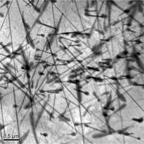Article contents
Effects of minor Y addition on microstructure and mechanical properties of Mg–Nd–Zn–Zr alloy
Published online by Cambridge University Press: 18 July 2017
Abstract

Microstructure and mechanical properties of Mg–0.43Nd–xY–0.08Zn–0.11Zr (x = 0, 0.03, 0.06, and 0.12 at.%) alloys were investigated. The results indicated that Mg24Y5 phase was formed in the as-cast Y-containing alloys, the grains were refined and the amount of needle-like Mg12Nd phase in the α-Mg grain interior was increased with increasing Y addition. After solution treatment, the Mg24Y5 phase and needle-like Mg12Nd phase nearly completely dissolved into the α-Mg matrix and long-rod-like Zn2Zr3 phase occurred. The amount of Zn2Zr3 phase was increased with increasing Y content after age treatment. Mg–0.43Nd–0.12Y–0.08Zn–0.11Zr alloy exhibited the best combination of strength and elongation in all conditions, especially in the temperature range of 200–300 °C, and an Arrhenius model was established to study the plastic flow behavior. The improvement in mechanical properties was attributed to the grain refining, solution strengthening and enhanced precipitation hardening of Zn2Zr3 phase and β-type phase.
- Type
- Articles
- Information
- Copyright
- Copyright © Materials Research Society 2017
Footnotes
Contributing Editor: Yang-T. Cheng
References
REFERENCES
- 6
- Cited by





